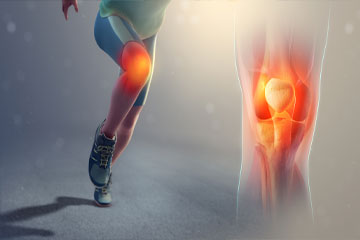Knee Sports Injuries
The knee joint is one of the largest, strongest, and most imperative joints. The knee joints are the femur and the tibia. A tiny, thin and long bone that runs along the tibia (fibula) and the kneecap (patella) are the additional bones that sum up to make the knee joint. Bone surfaces of the knee are covered with a smooth surface (cartilage). Ligaments are stretchy supports required to provide immovability to the knee by joining the knee bones. The meniscus is a two, pillow structure inside the knee joint, needed for stability, and nutrition of the joint.
The knee joint helps in mobility and rotating movement. It acts as a hinge and permits the lower leg and foot to move back and forth flexibly while walking, twisting, and sitting. It makes possible great stability while standing up.


Common Knee Injuries and Conditions
Because the knee joint is a weight-bearing joint, it is prone to various injuries and diseases. The most common knee injuries are:
ACL Injury (Anterior Cruciate Ligament)
The ACL is one of the key ligaments in the knee, providing stability and preventing the tibia (shin bone) from sliding too far forward. An ACL injury typically occurs during activities that involve sudden stops, jumps, or changes in direction, such as in basketball, soccer, or skiing. It can either be a partial tear or a complete rupture.
PCL Injury (Posterior Cruciate Ligament)
The PCL is another ligament in the knee that connects the femur (thigh bone) to the tibia (shin bone). It is responsible for preventing the tibia from moving too far backward. PCL injuries are less common than ACL injuries and often occur from a direct blow to the knee, such as in a car accident or a tackle in football.
Meniscal Tears
The meniscus is a cartilage in the knee that acts as a cushion between the femur and tibia. Meniscal tears are common knee injuries, especially in athletes. A tear can occur during activities that involve twisting, pivoting, or heavy lifting. These tears can be classified into different types, including horizontal, vertical, and complex tears.
Collateral Ligament Injury
The collateral ligaments (medial collateral ligament or MCL and lateral collateral ligament or LCL) are located on the inner and outer sides of the knee, respectively. They provide stability to the knee by preventing it from moving side to side. Injuries to these ligaments usually occur due to a direct blow to the side of the knee or a twist during physical activity.
Fracture & Dislocation
Fractures refer to broken bones, and dislocations involve the displacement of bones from their normal position in a joint. In the knee, fractures typically affect the femur, tibia, or patella (kneecap), while dislocations usually refer to the kneecap (patella) being displaced from its normal position.
Sign and symptoms
- Initial: Swelling | Inability to bear weight on affected limb| Painful movements.
- Prospective: Feel the terror of falling | complexity in climbing stairs | Lack of self-confidence in knee | thinning of thigh muscles.
- Treatment- In cases of Partial tear, dealing with exercises and precautions & in cases of high-grade tears Arthroscopic Surgical modernization is compulsory.
Every Information about Ligament Injuries of knee
Partial ACL tear
Condition where your ligament is damaged partially ( only some part of Ligament is torn or stretched ) In this case your doctor confirms diagnosis with some clinical tests and Investigations .
PRP treatment
Looking upon your condition you may be advised for PRP treatment with specific guided strengthening or Sometimes ACL augmentation or Single Bundle reconstruction . As we believe you are an individual so we customized treatment as per your specific needs .
